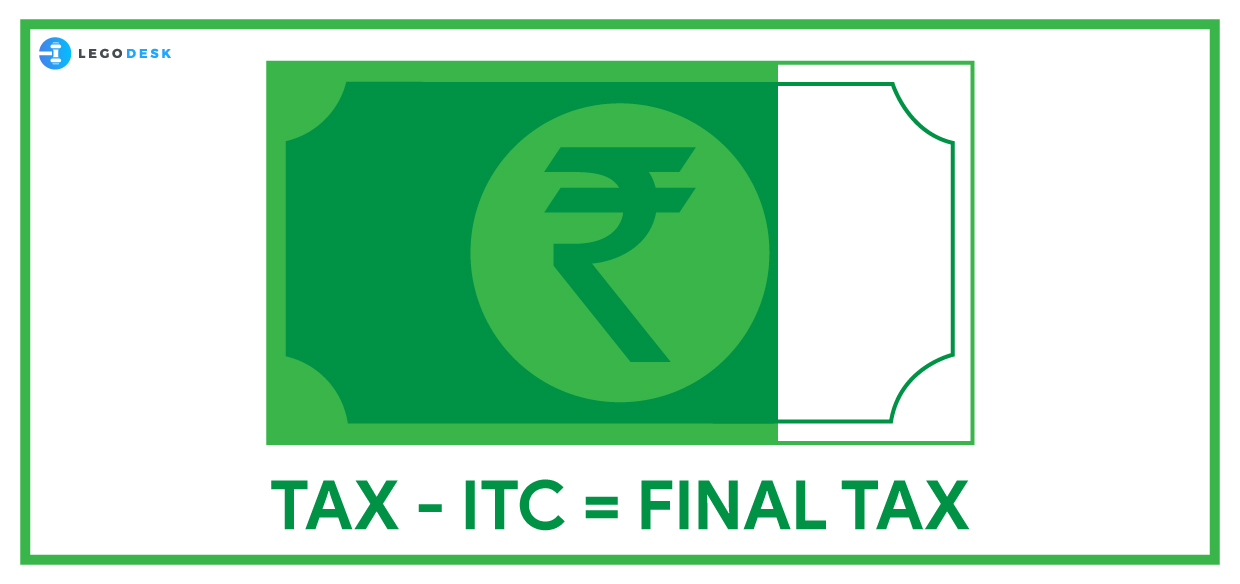
The Government of India, in 2017 introduced Goods and Services Tax to replace all of the other taxes like Sales Tax, Value Added Tax, etc.[i] This has turned out to be a rather significant reform in the Indian Economy. People now understand taxes more easily than ever. However, one of the most important things about this new tax is – The Input Tax Credit under GST.
Meaning of Input Tax Credit?
Input Tax Credit means reducing the taxes which are paid on Inputs from the taxes to be paid on the output. In simpler terms, at the time of payment of tax on output, one can reduce the tax already paid on input.
Imagine a person A is a manufacturer of tables and chairs. The tax paid by him on the raw materials for one table is 400 rupees and the output tax to be paid for the table is 600 rupees. The final tax to be paid by A will be 600-400 = 200 rupees and the Input Tax credit claimed is 400 rupees.
Input Credit Mechanism is available to a person when they are covered under the GST Act. It means when one is a manufacturer, agent, supplier, aggregator, e-commerce operator, etc, registered under GST, they can avail the benefit of Input Tax Credit.
How to Claim Input Tax Credit?
Some conditions must be fulfilled in order to claim Input Tax Credit on GST:
- It is only available to register a taxable person.
- ITC is only available when the goods and services received are for business use, which includes resale.
- Input Tax Credit may also be claimed on exports and are taxable.
- In case, the constitution of business changes due to sale, merger, or transfer of business, the balance ITC will be transferred to such business.
- One can credit the Input Tax Credit in his Electronic Credit Ledger on the common portal in a provisional manner. It is prescribed in model GST law.
- One needs supporting documents such as tax invoice, debit note, supplementary invoice to claim the ITC.
- Also, the actual receipt of goods and services should be present to claim Input Tax Credit.
Working of ITC under GST
Let’s imagine, Mr. A is a seller. He has sold goods to Mr. B. The buyer Mr. B is then entitled to claim the purchase credit using his invoices.
This is how it works:
- A will upload his tax invoices details as issued under GSTR-1.
- Then, the details which Mr. A uploaded is automatically populated or reflected in GSTR-2A. This same data gets reflected when GSTR-2 returns are filed by Mr. B which are details of his purchase.
- B then accepts and acknowledges the details of the sale, and then, Mr. B’s ‘Electronic Credit’ is credited with the purchase tax. He can either use it to adjust it for later future output tax liability and receive a refund.
Types of GST
There are mainly 3 types of taxes under GST –
- Central Goods and Services Tax(CGST)
- State Goods and Services Tax(SGST)/ Union Territory GST(UTGST)
- Integrated Goods and Services Tax (IGST)
CGST and SGST/UTGST are charged for the intra-state supply of goods and services. However, for the inter-state supply of goods and services, IGST is charged. ITC is applicable to all these taxes.
While making the payments for these respective taxes, ITC is allowed in the following manner;
| Credit | First utilized for payment of | Balance, if any |
| CGST | CGST | IGST |
| SGST/UTGST | IGST | CGST then, SGST/UTGST |
| IGST | SGST/UTGST | IGST |
Documents required to claim Input Tax Credit
The applicants require the following documents in order to claim Input Tax Credit under GST:
- The invoice for the supplied goods and services according to GST law is necessary.
- A supplier issued a debit note to the recipient in case of payable tax or taxable value as specified in the invoice is less than the tax payable or taxable value on such supplies.
- Bill of entry.
- Also, an ISD (Input Service Distributor) issued a credit note or invoice according to the GST invoice rules.
- Under certain situations, an invoice issued like the bill of supply instead of the tax invoice. It happens when the amount is less than 200 rupees or in conditions where the reverse charges are applied according to the GST law.
- Also, a bill of supply issued by the supplier for goods and services or both as per the GST invoice rules.
Conclusion
Since GST is charged on both goods and services, Input Tax Credit can be claimed on both goods and services. The input tax credit is allowed on capital goods. But, an Input tax credit is not allowed for goods and services for personal use. Hence, only businessmen can avail ITC on GST.
It is also possible that there may be Unclaimed Input Tax Credit. It happens when a tax on purchases is higher than the tax on the sale. In such a case, you are then allowed to carry forward the credit or claim a refund. The input tax credit cannot be taken on when the purchase invoice is more than one year old.
Also, no input tax credit is allowed after GST return has been filed for the month of September after the end of the financial year to which such invoice pertains or the filing of the relevant annual return, whichever is earlier.
[i] The Central Goods and Services Tax 2017.

